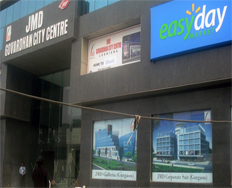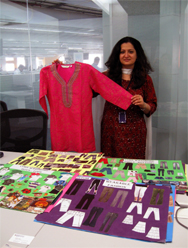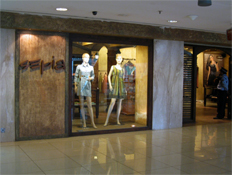
Martha S. Carper
Assistant Professor,
Fashion and
Apparel Studies,
University of Delaware
Martha Carper is an assistant professor of Fashion and Apparel Studies at the University of Delaware. Carper holds a B.S. degree from Appalachian State University and an M.S. degree in textiles and clothing from the University of Tennessee, Knoxville. She has over 27 years of industry experience in textiles and apparel during her career at the DuPont Company, where she was a global business manager responsible for over $300 million in global sales of Lycra.® While at DuPont, she also served as president of a global start-up venture in the apparel industry. She has conducted business in more than 25 different countries and has direct experience
at all levels of the apparel value chain (fiber manufacturing through retail) as well as military apparel, home
textiles, and nonwovens.
My first trip to India was in 1995 as global business manager for Lycra® at the DuPont Company. We made a quick, three-day trip to visit the DuPont offices in India to better understand the textile and apparel industry and the potential to market Lycra® in India. Twelve years later, in March 2009, as I walked off the airplane and through the airport, I could tell that India had gone through a massive transformation!
The airport had been modernized, and men and women in the airport were wearing more Western apparel. There were still lots of women dressed in traditional Indian saris, but I could sense the change that had come over the country in a little over a decade. On the way to our hotel, the streets were still jammed with cars, buses, cows, and the occasional camel or elephant, but the streets were now surrounded with modern buildings and towering skyscrapers. It was clear that change had happened so quickly that the old is now part of the new, almost like an old house that had been redecorated so quickly that the decorator forgot to take out the old décor! As we rode to our hotel, I became extremely curious about the changes in both the textile and apparel industries.

The objective of my research was to study the retail market in India and the manufacturers who serve the export market in the U.S. and globally. Time did not permit me to visit a large number of retailers. Based on numerous discussions with the U.S.-India Business Council, we selected several apparel manufacturers and retailers to visit to provide an overview of the industry. In addition, we spent lots of time (and money!) in the modern malls and retail shops to become more familiar with the progress of retail in India. The research also gave us a glimpse of the India of the past and how the old and the new are actually coexisting.
India represents the second most populous country and the fourth largest retail market in the world.[1] There are over 10 million tiny retailers in India that make up India’s $350 billion retail market. The retail industry in India is expected to double by 2015. Understandably these tiny retailers, most of whom are family-run shops, are very concerned about multinational retailers entering the country and devouring them. India’s government prohibits foreign multibrand retailers to operate as retailers in India. India does permit foreign single-brand retailers, such as Nike or Reebok, to have up to a 51 percent stake in a joint venture with a local company in India. Multibrand retailers, such as Wal-Mart, are allowed to have business-to-business wholesale cash-and-carry operations and franchise arrangements. [2]

In 2007, Wal-Mart, the world’s largest retailer, announced a 50:50 joint venture agreement with Bharti Enterprises, a large conglomerate involved in transportation and communication in India. The initial focus of the JV is a wholesale cash-and-carry business primarily for food distribution.[1] However, the JV also provides Wal-Mart an opportunity to provide the back-end supply chain management for Bharti’s franchise stores called “Easy Day.” These Easy Day stores are much smaller than the traditional Wal-Marts found in the U.S. The Easy Day stores will provide Wal-Mart an opportunity to enter the retail market without the use of the retail name “Wal-Mart.” [3]
Even though Wal-Mart is the number one company on the Fortune 500 list and has a reputation for the most sophisticated supply chain system in the world, Wal-Mart has found India to be a real challenge. “India is a unique market because India has had an evolved wholesale network for several centuries,” said Raj Jain, Wal-Mart India’s president. According to Jain, Wal-Mart’s biggest challenge in India is that there is no organized supply chain. “Because of that lack of supply chain, there is no forecasting, there is no understanding of how demand is. There is no transparency about pricing, and for perishables, there is no refrigeration.”[4]
Wal-Mart India is headquartered in Gurgaon just outside of Delhi. The offices are in a business complex of modern buildings with other international companies. As we got off the elevator it was difficult to tell whether we were in India, New York City, or even Bentonville, Arkansas. The glass partitions and the office cubicles were typical of any Fortune 500 company. Our contact at Wal-Mart had arranged a visit with Wal-Mart management as well as a review by Wal-Mart’s apparel development team about their plans for apparel in India.

The Wal-Mart development team (including two Indian women dressed in saris) reviewed the line of both traditional Indian apparel and Western apparel. I left with the impression that Wal-Mart had been smart to include Indian women educated at local fashion design schools to help execute their apparel strategy.
In order to learn more about the retail landscape, Wal-Mart suggested we visit the local malls and department stores to get a perspective of the growth of retail in India. We explored several shiny new retail malls and shops to become more familiar with the “new” retail market in India. A visit to “Big Bazaar” in Ahmadabad proved to us that we are not the only country with “big box” stores. This large, six-story store reminded me of traditional ”big box” stores in the U.S., complete with a blaring bull horn announcing their version of “Blue Light Specials”! India also has its versions of a typical JCPenney called “Pantaloons” and “Westside.” All of these stores carry both traditional Indian garments as well as Western styles side-by-side in the store. These clean, well-organized stores are the wave of the future for India’s growing middle class. (One additional point related to our excursions to the malls and stores: Security was very tight. We had to walk through metal detectors at every mall and also at the larger stores.)
The second part of my research was to investigate the garment manufacturers who supply the export market. There are four or five large garment manufacturers important in the export apparel market. Based on advice from Wal-Mart and the Indian Business Council, we arranged visits to two apparel manufacturers who supply the U.S. apparel market. Texport, in Mumbai, and Shahi, near Delhi, have become important suppliers to retailers such as Gap, American Eagle, Abercrombie, and Wal-Mart. Both Texport and Shahi export apparel to customers in the U.S., Europe, and Australia. During our visits, both companies shared their excitement for growth in the apparel export market. Shahi and Texport have modern textile manufacturing and sewing equipment and well-trained personnel in apparel design and product development. Both companies also shared their commitment to safety and sustainability and reported that safety and sustainability is a “condition to play” in the global apparel market. One interesting fact about Shahi was that the son of the president of Shahi is a recent graduate of the University of Pennsylvania who is currently in Macy’s training program. It’s a small world!

In addition to apparel production, Texport has recently launched a retail apparel initiative in India with plans to capitalize on the growth in apparel as young women transition from traditional saris to Western wear. Today, over 90 percent of all women in India wear saris; however, Texport predicts that more and more women will transition part of their wardrobe to Western apparel. The retail shops called “Sepia” feature upscale women’s inspirational Western wear. They have six stores and are planning to open more stores in the future.
In summary, it is very clear that opportunity exists both at the apparel and retail level in India. The rate of growth will depend on several factors: the global economy, the government’s interest and assistance in driving growth in textiles and apparel opposite other growth opportunities, and the political stability of the region, which at this time is a point of real concern. Indian also faces a multitude of other issues such as education, clean water, and infrastructure that are outside the scope of this document.
Just one last closing comment about India. I believe that too often people view India and China as similar countries; both countries have over a billion people and have experienced rapid rates of growth over the past decade. However, that is about the only thing they have in common. One of the major differences is the fact that India is the world’s largest democracy. We were in India at the height of the political season, just weeks before the national elections (actual voting takes a month!), and we witnessed the frenetic pace of campaigning by some 300 political parties and their candidates in the newspapers. Recent results of the election (since our return to the U.S.) gave the Congress Party a second chance to provide the necessary foundation to the Indian people.[5] I am optimistic that this country is on the right track — it is a beautiful country with beautiful people.
References
1. money.cnn.com/2005/06/06/news/fortune500/walmart_india/index.htm
2. www.reuters.com/article/consumerproducts-SP/idUSBOM10185320070806
3. www.domain-b.com/industry/retail/20070806_wal_mart.html
4. http://knowledge.wharton.upenn.edu/india/article.cfm?articleid=4305
5. Good news from India, the meaning of the world’s biggest election. The Economist, May 23, 2009. p.13.